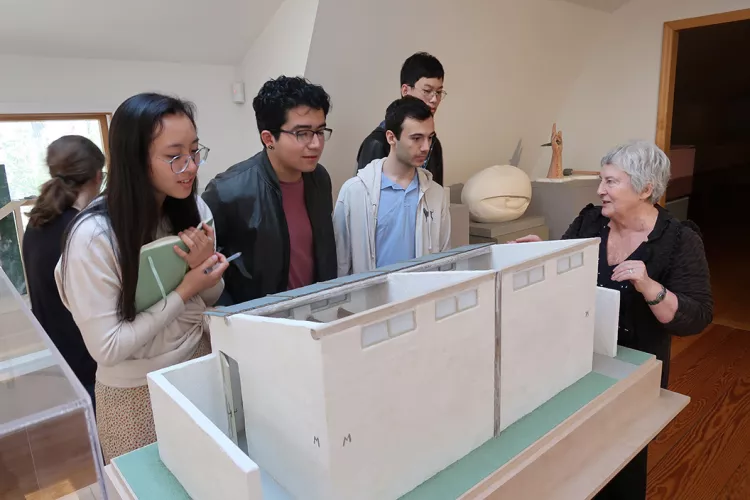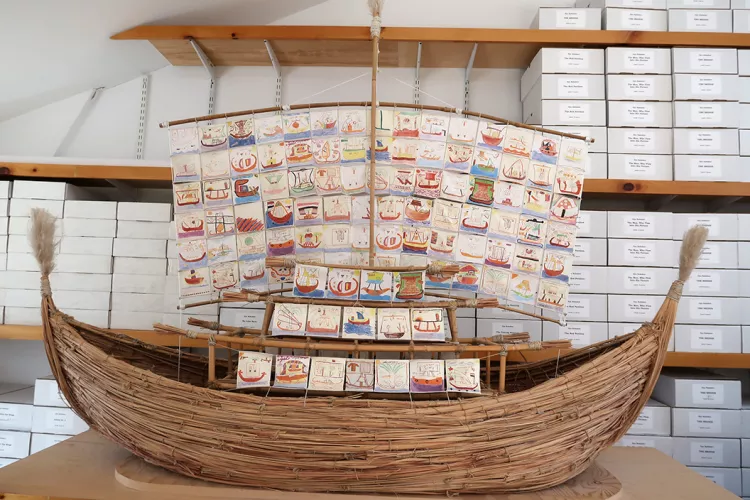Transforming and Encompassing Reality: Students Experience Russian Art Firsthand

Artist Emilia Kabakov shows Bellara Huang ’21, Gabby Cepeda ’22, Kai Petkov ’22, and Yuxiang Wu ’21 a model of the installation, The Toilet.
Somewhere on the far end of Long Island reside Emilia and Ilya Kabakov, two preeminent Russian working artists. It is an idyllic space, located just off the coast and secluded from the street by a copse of trees. However, when you enter their studio-compound, as Visiting Assistant Professor of Russian José Vergara and nine students recently did, the world shifts around you.
In Ilya’s paintings, which he sometimes covers with colorful candy wrappers or painted symmetrical dots, you witness his peculiar vision of the world, one that he struggled to see clearly while living in the oppressive Soviet Union until his emigration in the late 1980s, and one that nonetheless remains unclear to him even in his life abroad. In their jointly conceived and realized installations, too, you witness how the Kabakovs’ imagination breaks all bounds, merging many media and genres, the mundane and the sacred.
When plans to host a lecture by Emilia at Swarthmore fell through, she extended an invitation to Vergara to bring students to their studio instead. Co-organized by the Russian Program and the Department of Art and Art History, this trip provided students with the opportunity to engage with Russian culture firsthand and to learn more about the Soviet-Russian avant-garde and its continued practice.
“It is not often you get a look into the works and processes of accomplished artists, let alone ones of such renown as the Kabakovs,” says Kai Petkov ’22, of New York, N.Y.
The Kabakovs are perhaps best known for their total installations—a type of artwork they pioneered that ranges in size from a small room to an entire gallery and that aims to transform and encompass the viewer’s entire reality through sight and, often, sound. Emilia joked that they are “totalitarian artists,” both in their vision and in their demands regarding how their works are displayed.
During the visit, students toured the Kabakovs’ various workspaces. They began in a barn-size gallery that houses some of Ilya’s paintings, ranging from the 1980s to the present day. Several massive multi-canvas pieces lined three of the walls, while many other relatively smaller paintings filled the rest of the room. As Emilia explained, Ilya’s recent work explores the possibility of combining two different styles—for instance, socialist realism and classical renaissance—in one painting. Other works cite Ilya Repin’s Unexpected Return (1884-88) and Constructivism all at once.
“I was so in awe seeing a monumental space for Ilya Kabakov’s paintings; I felt small in comparison,” said a senior studio art major. “I enjoyed seeing the evolution of his works and hearing Emilia talk about his thoughts and processes for them. Observing his subjects and techniques gave me new inspiration to apply in my own works.”

The Ship of Tolerance, a project that asked children from around the world to discuss the meaning of tolerance.
From there, the group explored the Kabakovs’ workshop and, above it, their gallery of installation models. This museum of projects both realized and unrealized demonstrated the breadth of the Kabakovs’ artistic vision through dozens of scale models. Emilia explained their intent and the logistics of realizing often quite complex pieces. She described, for instance, how a Russian millionaire requested the installation How to Meet an Angel, which features a very tall ladder structure reaching into the sky and a person perched at its tip in anticipation of an angel, to be built in a Moscow park. The catch: He demanded to have the titular angel actually present, somehow hanging from the sky. After much back and forth, including Emilia’s explaining that she isn’t in charge of angels, she finally hit upon a solution: Drones would appear every so often during the installation’s duration.
In all, the visit to the Kabakovs’ studio gave students insights into the multiple realities of the art world: that of the artists’ imaginations, as well as of the practical side.
“As an art history student interested in curatorial path, it was intriguing to hear about the artist’s honest opinion of working with curators,” said Rina Kiyohara ’20, an art history and Chinese major from Tokyo, Japan. “Direct engagement with the artist provided me a great opportunity to learn how to ask practical questions and how to approach the artworks in the artist’s presence.”
Swarthmore is investing in its vibrant intellectual culture. Learn how at lifechanging.swarthmore.edu.



